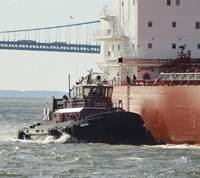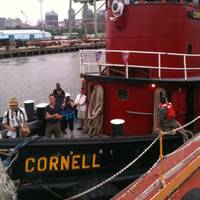“Lies, Damned Lies & Statistics”

Popularized by Mark Twain and generally credited to 19th-century British Prime Minister Benjamin Disraeli (1804–1881)*, the above line, which in its full form is “There are three kinds of lies: lies, damned lies, and statistics” is one of my favorites. This being our June 2013 “Yearbook” edition, a publication literally packed with – statistics – I will leave it up to you, the discriminating reader of our pages, to determine the veracity of the numbers reported within. I start with a sincere thanks to Dr.
Random Roamings within the Moran Fleet

We all appreciated Don Sutherland's celebration of the 150 years of Moran towing (Maritime Reporter & Engineering News, April 2010). It was an exciting collection of vignettes on the life of the company and of its founder, Michael Moran. There were many other aspects of that remarkable company and of its equally remarkable founder that might further inform, if not entertain, the readers of Maritime Reporter. Rarely has a Moran tug been lost, but during the 1890s one vessel was overcome by heavy weather conditions immediately outside of New York harbor.
Sutherland: NYC Maritime Community Bids Farewell

A memorial service for longtime Maritime Reporter and MarineNews writer/photographer Don Sutherland was held aboard the Mary A. Whalen at Brooklyn’s Red Hook Pier 9B last night. The event to celebrate the life and good works of the popular marine industry figure, who died on May 24,2010 following a brief bout with cancer, drew a crowd from many corners of the local maritime community, as well as an eclectic mix of family, friends and colleagues. Pictured here is the historic tug…
Pollution Prevention Assignments
SMIT Salvage came to the rescue of Zhen Hua 010 when it grounded off of carrying five large ship-to-shore cranes. Ironically, this ship is featured prominently in another feature in this edition of MarineNews, coincidentally in Don Sutherland’s report of large crane deliveries to the . SMIT Salvage has a role in removing threats to the marine environment. For example, during the second quarter work began on the recovery of oily residues from the wreck of the Haven. This VLCC went down off the Italian coast in the 1980s following an explosion and fire. There is no cargo oil remaining inside the wreck's tanks. The aim of this project…
Reborn on the Fourth of July

It's sometimes said that great harbor cities don't appreciate their harbors, so the city of New York must be an exception. Look what happens every Fourth of July. For years without missing, regular as clockwork, Macy's fireworks display has locked-down the harbor with skies in eruption, which the masses trek shoreward to see. Around either side of that date, the fireworks season brings the burghers of Manhattan, the boaters and bathers of the Boroughs to their esplanades and beaches. Few of them know how those big black barges full of fireworks got there, but lo and behold, there they are.
Investigation Begins on Fatal Ferry Crash

Investigation begins on yesterday's ferry accident that has seriously injured several passengers and killed 10. A Staten Island Ferry crashed as it was docking Wednesday afternoon, severely injuring several passengers and killing at least 10. As New York City rush hour began to peak, the incident occurred at about 3:20 p.m., as the vessel was en route to dock at the St. George Terminal on the Staten Island end of its Manhattan commuter route. According to reports, the front end of the ferry suffered damage to the right side of the hull.
Vessels: Year Two A Tale of Tugs of Two Cities
It's been a year since MarineNews linked the dual tugmeets of the first week of September, one in New York City, the other upstate, at Waterford. Coupled, they make an interesting study, for their differences as much as their similarities. The tugs of New York City come in all sizes, but are typically large. Just as New York is a city of (many) skyscrapers, so it's a city of (many) monster tugboats, as harbor craft go. Waterford, a few miles north of Albany, is the gateway to the Erie Canal - is actually on the canal. While New York State's canals have renewed potential for commercial service, they're known most widely as recreational attractions for people who drive (many) large and pricey boats.
Portland Gets Boost from Oil Rig Project

Portland’s marine commercial shipbuilding industry is getting a boost thanks in part to construction of the “Pride Portland” and the “Pride Rio de Janeiro,” two huge oil rigs built by crews working for Cianbro and funded with a $342 million loan guarantee from the U.S. Maritime Administration (MARAD). Maritime Administrator Captain William G. Schubert recently visited the “Amethyst Project” at the terminal where the two 12,000 ton oil rigs that symbolize the city’s revitalization efforts were constructed.
Feature: Ship Enters Harbor, Returns Without Incident
How many great ships have graced the front page of The New York Times? In a century and a half of publication, the newspaper of record has featured plenty. Ships were once the technological measure of civilization, like the automobiles and aircraft and TVs and PCs and Gameboys that followed. All of them characterized and defined an epoch, an age, a generation. Each changed the things people did, the way they saw, how they thought, spoke, and behaved. Yet of all those technological inspirations, the most truly regal, the most romantic were ships. They are the most embracing. People dine and sleep aboard. Some earn their livings and some play. All go to the bathroom, many recreate, perhaps even procreate on ships. People are sometimes born on ships.
Feature: Bye, Bye Redbird
Some people hate the subways. During rush hours at least, bodies are crushed unwilling and unwelcome into an unwanted intimacy, violating a million years of biological and emotional evolution. People utilize the subways, even appreciate the subways as the fastest way to get around. During non-rush hours, they're even attractive in their utilitarian way, and yes, there are subway fans and enthusiasts - the biggest concentration, perhaps, on the staff of the New York City Transit Authority itself. But to the riding public at rush hour, they're the monument to alienation, to being alone in a crowd, to urban isolation. They're the archetype of doublethink - you imagine you're a free spirit, even in this claustrophobic crush. If existentialists are not born, surely here they are made.
Feature: Boats We Love
Every harbor has its share: hardworking boats that stand-out for some provacative reason. It's probably not for their beauty. Form follows function in most maritime architecture, and maybe there's a beauty in how functional these boats are. But such beauty resides in the mind more than the eye. And yet they're still head-turners. Every harbor has its share. In New York, three come to mind - aphabetically, Odin, Shelby Rose, and Twintube. You know 'em on sight. The first two are tugs, and sort of look it. As for the third, "I was trying to build something that would do everything," Luther Blount told us. It does. They do. They say you'll see boats that resemble her out west. We've seen similar craft heading up the Rhine in Europe. But on New York harbor, Odin looks unique.
Anyone Want to Restore a Tugboat?
You'd think it would be easy to start a tugboat museum. First, get an old tugboat. Clean-up some rust with a pad of coarse steel wool, slap-on a coat of paint, and presto, you're ready to sit in the booth and sell tickets. Everyone would applaud your efforts because, first, everyone loves tugboats and all they represent - solid construction and earnest purpose, hard work and benevolent contributions to civilization. And second, because old tugboats, all spiffied-up, are handsome sights, an alluring environmental decoration wherever they're found. And third, because the design of tugboats, like most of society's tools, has undergone great change, and the old ones are dying-off fast. You'd think everyone would support your labors at preserving a noble cultural heritage.
What is in John Garner's Pocket
You don't really know a boat until she's hauled. Plying her trade on the water, her best half's submerged out of sight. We think we recognize her - "oh, there's Odin," or "Shelby Rose," or "Twintube" - but what are we seeing? The lines of the deckhouse, the shape and placement of the wheelhouse, the arrangement of the stacks? These are the parts known as the superstructure - "super," in this case, meaning simply "upon." It's a little like saying we recognize someone by his hat. The boat's defining structure starts at the main deck and goes downward from there. What little we see of it is low on the horizon. There's the deck's line, along with a smattering of bulwarks.
New York's New Faces
How many vessels entered New York Harbor for the very first time in the past year or two? Oh, probably a million. And probably most of them kept going, up the North River, out the East River, up to beantown or clamtown in one direction, cheesetown in another. Stop for a snack in New York, it's Boar's Head 24x7. Forty-eight hours later, it's catfish. Near everything, there are a lot of good reasons to come to New York, and a lot of good reasons to leave. A lot of good reasons to stay too, sometimes. Quite a few new faces have done just that, making New York Harbor all the handsomer. We thought we'd look a few over. At least four of the boats are new builds, arriving since May 2003; the others are acquisitions to enlarge and upgrade their fleets' capabilities.
The Empire State Navy
Of all the waterways in fable and lore, the Erie Canal is famed least for its maritime nature. Lake Superior may have swallowed the Edmund Fitzgerald, and the North Atlantic holed the Titanic, but they sing of the Erie Canal for a mule named Sal. The triumph of the canal was over land, not water. Fully 363 miles long, scaling mountains 500 ft. above sea-level with 83 locks, fording natural rivers on aqueducts or "water bridges," it was a pick and shovel and trowel job of a stupendous scale, so grandiose that some called it madness. Yet the original "Clinton's Ditch" helped write the destiny of North America, so greatly that in return it required expansion and major rebuilding twice, within its first ninety years.
STILL FIGHTIING FIRES AFTER ALL THESE YEARS
How much water has flowed under the bridge since 1938? Well, for starters, the bridge itself - in this case, the Verrazano-Narrows - wasn't even built yet. We had no PCs, no CDs, no LPs, not even TVs in 1938. Manhattan's shore ended at West Street, which bristled with steamboats and their docks. Hundreds of daily arrivals brought people and cars and horse-drawn wagons across the North River, from the Garden State and the terminals of powerful railroads. Containerization, like cartridgization and cassetization, were yet to be thought of, and so were containerports. So was the strip of the Kill known as gasoline alley, and events it would sponsor - the Exxon/Mobil blast a year and a half ago…
Editor's Note
Your standard "It was a good year/It was a bad year" round-up falls well short of summarizing the events of 2001, and their effects on the immediate and long-term future in our industry. Simply put, there are no words to describe the horrific events that transpired on September 11 in New York and Washington, D.C., but three months later, it is increasingly easy to see the fundamental and far-reaching impacts the events have had — and will continue to have — on the maritime industry. Safety and security, ever the mantra of the International Maritime Organization and quality ship and boat owners around the world, take on a more serious and urgent tone.
WTC Clean-Up: Getting Down and Dirty
The enormity of the September 11 terrorist attacks on the U.S. have effectively changed the world's collective attitude toward security, particularly in regards to the potential use of the maritime industry as an instrument of destruction. While the events of early September are global in scope, they are also an intimate local affair. As the New York area continues the gargantuan clean-up task, Don Sutherland reports on the maritime industry's role in helping out. It's not so easy to believe two opposites at once. "I try to treat it like an ordinary scrap-removal job," said Capt. Virginia has just left the basin at Pier 25, North River, with a load of debris, bound for the Port Authority Pier 6 in Brooklyn.
A Tale of Tugs of Two Cities Year: A Tough Season on the Circuit
It's been a rough year for tugmeets. Charleston, Boston, and Portland, whose Musters we've covered in the past, were respectively, skipped, canceled, and postponed. The World Ship Society tells us they'll be back next year with the Boston event, and the Portland muster, pre-empted by Hurricane Charlie, is taking place as this is written. We wish we could have gone north. While there are all sorts of good reasons to attend a tugmatch, we, being media people, think mostly about the good press they bring the business. The way things are shaping-up in such realms as national security, the price of fuel, environmental cleanliness and such, waterborne transport displays more and more advantage for the good of all.
In Remembrance: Captain Fred Kosnac Jr. (1928-2004)

Capt. Fred Kosnac was the first tugboater I ever met. If a career can be considered in spiritual or symbolic or abstract terms to be "a life," then Fred Kosnac would rightly be called the patriarch of mine, as a writer and photographer and admirer of tugboaters and tugboats. The matriarch was of course a tugboat proper, the Hay-De, which Capt. Kosnac, based on a phone call out of the blue in 1980, made available to a curious and impressed young journalist. You mean something that works so hard, and has been at it since 1887, is still intact?
Steering into the Future Aboard Lincoln Sea
Everyone knows everyone else's business in this industry, or at least they think they do, and certainly try to. Who owns this or is buying that is information as eagerly sought for tactical insight as it is for gossip, and is equally protected by those in the know. The ex-S/R Everett, lately known as the Lincoln Sea, has been a buzz on New York harbor ever since the newswires hummed with reports that K-Sea had bought the Mobil-built boat. But that was back in January. If it's true, the scuttlebutt asked, how come the winter has passed, the spring has passed, and the boat's still painted blue - not the white superstructure, green decks, tan stacks, and red trim of K-Sea?
On Tugboats
There have been plenty of books published on the subject of tugboats in the past few years, sharing a cookie-cutter similarity - they're large, handsome, colorful, well-produced coffee-table volumes, which pretty much cover the same introductory material in the same glancing way. In all those regards and quite a few more, Virginia Thorndike's On Tugboats is a different sort of book. For starters, it's not large nor particularly handsome, and not all that well-produced - a standard paperback printed in black-and-white on paper that will probably not last for centuries. But then, it is a book crying out to be read, where coffee-table books ask merely to be seen.
Memo to the New Staten Island Ferries: Welcome to New York
How long does it take to build a double-ended municipal ferryboat? Any boat with two bows should have two answers, if not more. If by "build a ferryboat" we mean from the moment we start laying the keel to the moment the boat hits the water, we could say a ferryboat takes eleven months to build. Or anyway, that's how long it took Marinette Marine, Inc., a division of Manitowoc Corporation, to build the first in "the new Kennedy class" - at 310-feet and 7.1 million pounds loaded, with a $40-million price tag, the largest vessel constructed by the yard. Altogether, there are three. "The second two were identical," said Marinette Marine's Duane Roehm, Vice-President, Program Management and Planning, "but during the construction of the first, there was a strike.







